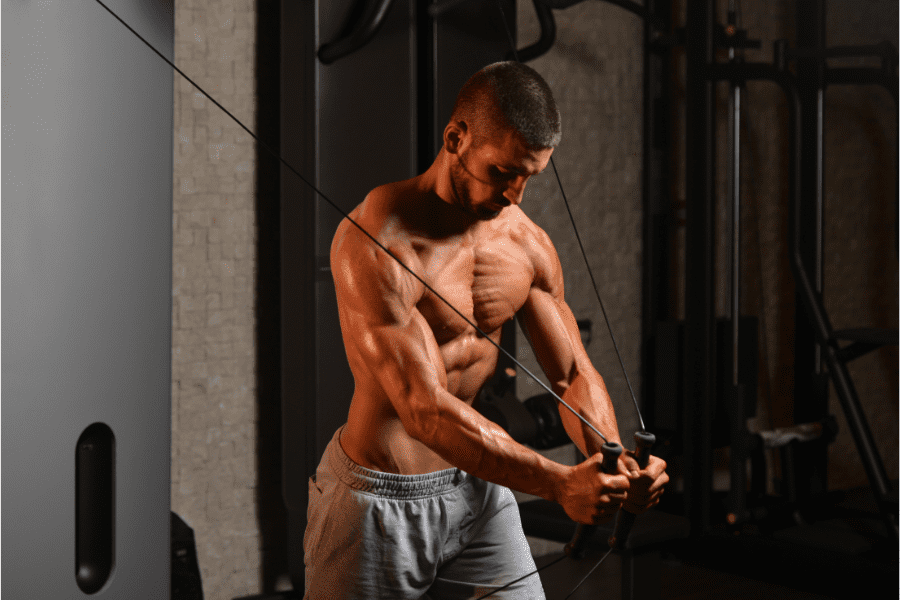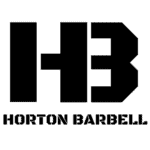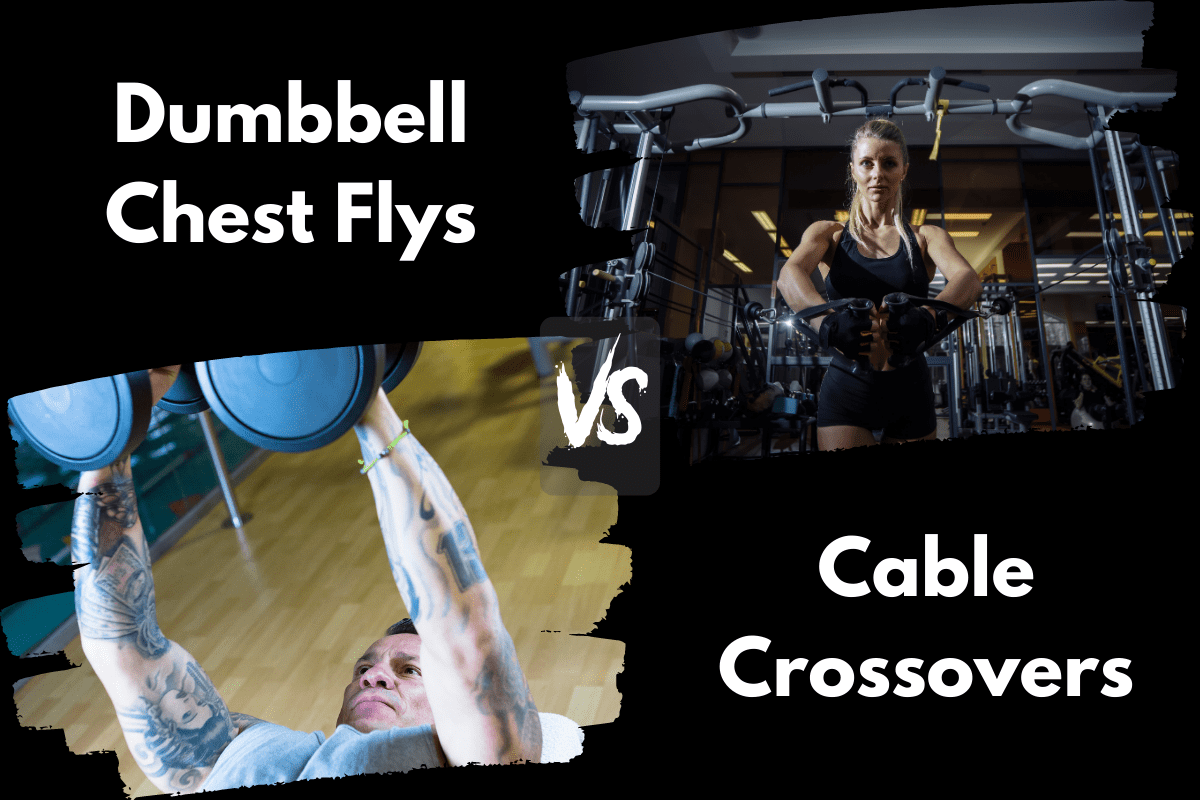Cable Crossover vs Dumbbell Chest Fly (Is One Better?)
If you’re looking to build a stronger chest, two exercises that are likely to be on your radar are Cable Crossovers and Dumbbell Chest Flys. Both exercises target the chest, but they differ in how they are performed and the equipment that they require.
Cable Crossovers, also known as Cable Flys, are a type of strength training exercise that is performed using a cable machine. The exercise involves standing between two cable stacks and pulling the cables across the body.
Dumbbell Chest Flys, on the other hand, are performed using a pair of dumbbells. The exercise involves lying on a flat bench and lifting the dumbbells out to the sides, similar to how you would open a book.
So which exercise is best for you? Both Cable Crossovers and Dumbbell Chest Flys can be effective for building chest muscle strength and size, but they do have some key differences. In this article, we’ll compare Cable Crossovers and Dumbbell Chest flys to help you decide which exercise is best for your training goals.
Cable Crossovers

Equipment Needed
- Cable Machine
Muscles Worked
- Chest (Pectoralis Major, Pectoralis Minor)
How To
- Place single-handle attachments on both sides of a cable crossover machine.
- Stand with feet shoulder-width apart and a slight forward lean through the torso.
- Hold handles with your arms spread and a slight bend in the elbow.
- Press the cables forward until your hands touch. (crossing the arms in the front will add more emphasis to the upper pectorals)
- Slowly bring the hands back to the starting position and repeat.
Coaching Points
Make sure both pins on each side of your machine are on the same notch.
If you’re simply looking for Cable Crossover alternatives, check out my 10 favorite Cable Crossover alternatives for chest day.
Benefits of Cable Crossovers
Some potential benefits of incorporating Cable Crossovers into a workout routine include:
- Targeted muscle activation: Cable crossovers allow you to focus on specific areas of the chest, such as the upper, middle, or lower chest. This can help to develop muscle balance and symmetry.
- Greater range of motion: Cable crossovers allow for a greater range of motion than traditional bench press exercises, which can help to improve flexibility and mobility in the shoulders and chest.
- Variety in workouts: Cable crossovers can be a great way to add some variety to your pressing workouts to keep your program from getting stale.

Tired of coming up with your own workouts? But don’t want to pay an arm and a leg?
I post workouts 5 days a week right here. (Did I mention they’re free?)
Dumbbell Flys

Equipment Needed
- Dumbbells
- Bench
Muscles Worked
- Chest (Pectoralis Major)
Step-by-Step Instruction
- Grab your dumbbells, sit on the edge of the bench, and sit the dumbbells on your thighs vertically.
- Take a deep breath, lie flat on your back on the bench, and get your dumbbells in position ready to press.
- Keep your feet flat on the floor and your butt on the bench.
- Pull your shoulder blades together and keep the back of your head on the bench. You will slightly arch your back. Keep your core tight and keep the shoulder blades pulled back tight.
- Press the dumbbells up.
- Now, keep a slight bend in the elbow and lower the dumbbells down until they’re at shoulder height.
- Finally, flex the chest and pull the dumbbells together, back to arm’s length over the chest.
- When your set is done, do not freely drop the dumbbells without checking your surroundings. You could drop the dumbbell and it might hit a person nearby. Or your could drop your dumbbell and crush your fingers on a dumbbell that was left next to your bench.
Coaching Points
Dumbbell Flys should not be done with heavy weights. Stay relatively light, keep the movement very controlled and focus on the stretch.
Remember to finish your sets with awareness so that you and your training partner/fellow gym members stay safe and injury-free. The best way to finish a set is to bring the dumbbells back to your thighs and stand up with them. Or have a lifting partner take them from you.
Benefits of Dumbbell Flys
Some potential benefits of performing Dumbbell Flys as part of a well-rounded strength training program include:
- Improved chest muscle strength and size: Dumbbell Flys can help to increase the strength and size of the chest. This can be especially beneficial for those who are looking to improve their appearance or who want to increase their upper body strength for sports or other physical activities.
- Improved shoulder stability: The shoulder muscles, including the rotator cuff and the deltoids, are also engaged during Dumbbell Flys. This can help to improve shoulder stability and reduce the risk of shoulder injuries.
- Increased range of motion: Dumbbell Flys can help to increase the range of motion in the shoulder joint, which can improve flexibility and mobility.
It’s important to note that Dumbbell Flys should be performed as part of a well-rounded strength training program that includes a variety of exercises for all major muscle groups. It’s also important to use proper form and technique to avoid injury and get the most out of this exercise.
Cable Crossovers vs Dumbbell Chest Fly: Is One Better?
Now, let’s take a side-by-side comparison of the two exercises to see if one is better than the other for a few common lifting goals.
Better For Developing Strength and Size: Toss Up
Cable Crossovers and Dumbbell Chest Flys are both similarly effective exercises for building strength and size in the chest.
One reason that Cable Crossovers and Dumbbell Chest Flys are similar is that they both involve similar movement patterns. In addition, both exercises can be modified by using different hand positions or weights to increase the difficulty and challenge the chest in different ways.
Another reason that Cable Crossovers and Dumbbell Flys are similar is that they both offer a similar range of motion and are going to be done with similar weights.
Ultimately, the better exercise for you is going to come down to equipment availability and personal preferences.
Better For Beginners: Cable Crossovers
Both exercises perform essentially the same function and both can be very beginner-friendly exercises.
The reason I give the nod to Cable Crossovers being the better exercise for beginners is that when doing flys with dumbbells it’s more possible to have poor technique that can lead to an injury.
If a lifter gets too wide with dumbbells and/or too heavy then the shoulder can be put in a really bad position. That’s not to say that also can’t happen with a cable machine, but it’s less likely.

Get Shredded… For Free
Get a free workout Monday through Friday, posted right here on Horton Barbell. These workouts are designed to help you get strong, in shape and look great at the beach!
Final Thoughts
I’ve just spent the last section of this article comparing which is better – Cable Crossovers vs Dumbbell Chest Flys. The truth is, there is no reason (assuming you have the available equipment) you shouldn’t have both exercises in your training program.
Both are great exercises for developing upper body strength and hypertrophy. Incorporating both exercises into your training program can also add variety and keep your workouts from getting stale.
So, my suggestion would be instead of trying to decide between the two exercises, figure out how you can utilize both Dumbbell Chest Flys and Cable Crossovers in your training plan.
More Links and Info
Check out how Cable Crossovers compare to some other popular chest exercises:

